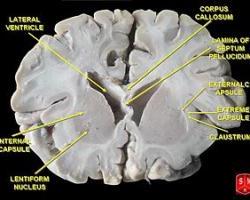Basal ganglia disorders are a group of syndromes that all have a common origin—namely, the basal ganglia, a part of the brain near the limbic system that is associated with many disorders, both psychological as well as physical.
These disorders are heterogeneous. That means that they are independent of one another; the only thing that they have in common is their site of origin.
The primary basal ganglia disorders are listed below, followed by a brief description of each.
Obsessive-Compulsive Disorder
Characterized by recurrent and intrusive thoughts, behaviors, or images that one perceives to be somehow grotesque or forbidden, OCD leads to severe anxiety and to repetitive behaviors that are aimed at reducing the anxiety level created by those recurrent and intrusive thoughts or images. Such compulsive rituals consume lots of time and can intrude on daily life. The caudate nucleus—which sends messages to the frontal lobe of the brain to tell us whether something is right or wrong—has been identified as being one of the areas where OCD begins.
ADHD
Attention deficit disorder or attention deficit hyperactive disorder is characterized by the inability to maintain attention and by excessive, unfocused activity. It is considered a developmental disorder although it is often diagnosed as a psychiatric one. It is believed that ADD/ADHD is caused by an underactive caudate in the basal ganglia.
Athymhormic syndrome
Also known as PAP syndrome, this disorder is characterized by a curious lack of motivation and lack of urgency. People with athymhormic syndrome tend to lose sight of the emotional importance of events, even those events that directly affect them. It is believed to be caused by damage to the caudate nucleus of the basal ganglia.
Tourette's syndrome
Tourette's syndrome is characterized by multiple motor/physical and phonic/vocal tics that are spontaneous and that tend to wax and wane inexplicably. It is believed that Tourette's syndrome is caused by problems originating in the putamen region of the basal ganglia, which is responsible for coordinating automative behaviors such as driving a car or riding a bike.
Parkinson's Disease
A central nervous system disorder, Parkinson's disease develops when neurons in the substantia nigra, part of the basal ganglia, begin to die off for no known reason. Because these neurons create the neuro-transmitter dopamine, the loss of these neurons leads to the progressive loss of motor function.
Huntington's Disease
Although Huntington's is a known hereditary disease, it is caused by the death of cells in a part of the basal ganglia called the caudate nucleus. Symptoms include progressive memory loss and motor function problems. The disease is fatal, although complications from the disease, including extraordinary depression leading to suicide, are generally the cause of death in Huntington's.



